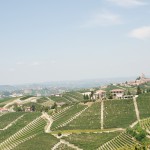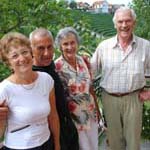The holiday edition! A visit to a royal ‘hunting lodge’ and a Vintner returns to Piedmont…
Author: David Berry Green
 Week 13 of wine adventures in Piedmont
Week 13 of wine adventures in Piedmont
August 15th marks ‘Ferragosto’, from the Latin ‘Feriae Augusti’ as the holiday was conceived by Emperor Augustus during the heady days of the Roman Empire in honour of the Gods, particularly those responsible for fertility and ripening, of course. So Italy empties to the coast while the luckless traveller is left scrabbling around for something decent to eat; a lottery as to what’s open and what’s not. Or perhaps that not-so-luckless traveller has scooped the 136 million Euro ferragosto rollover; in which case a Palazzo might be more appropriate…
La Venaria Reale, Turin (see the videos below), is one such palace although it’s not up for sale and is being restored as part of its status as a World Heritage Site (along with Il Palazzo Reale and La Palazzina di Stupinigi). To you and me it’s a palace, una Reggia, una Palazzo, but to the Savoia family it was a 17th Century ‘residenza di caccia’, a hunting lodge; though what of I’m not exactly sure. Several of the palace’s paintings seem empty of wild animals, of ‘cinghiale’ or wild boar that still roam these parts (indeed one trotted over Davide Rosso’s Baudana vineyard only last Friday, at about tea time). Rather, these works of art, some entitled ‘Sosta di caccia’ or ‘A break from the chase’, depict numerous fair maidens indulging their hosts and huntsmen – in lively debate I’ve no doubt.
Anyway, La Venaria Reale remains a stunning testament to a reign of nearly one thousand years during which the Kingdom of Savoia/Savoy encompassed (French) territory stretching from Nice north to Chambery, as well as that of Piedmont, Sardinia and Sicily. And despite the close attentions of one Napoleon Bonaparte during the late 18th Century, the Kingdom of Savoia became the Kingdom of Italy in 1861, a country unified for the first time since the Roman Empire; Vittorio Emmanuel of Savoia crowned as its King with the country ruled from Turin. Even at the time of the 1946 referendum, choosing a Republic in place of the Monarchy by a 54% majority, Piedmont remained loyal to its royal roots; roots which shaped modern Barolo and Barbaresco in the late 19th Century. Indeed, Davide Rosso’s family continue to supply Barolo to the Savoia family, the ones based in Genova.
 Talking of family, my Mum and Dad visited the region last week (see the phot left, where they are with the Rivella family). For Dad it was a return trip after a 15 year absence. Why? Because during the first visit, organised by the ancient livery company of Vintners, he recalls that he ‘did not fall in love with Piedmont wines’; finding the wines ‘not memorably attractive…being very heavy and somewhat acidic and tannic’. This time round, visiting the Barbaresco estates of Cigliuti and Rivella Serafino, along with Barolo’s Cantina Mascarello Bartolo and Giovanni Rosso, he writes of a ‘contrast’; of the ‘enormous care and pride taken in what they are doing’; how ‘the vineyards are well-tended and the cantinas immaculately clean and well-ordered’; and how ‘I have been most impressed by all those we have met and by the outstanding quality of their wines’.
Talking of family, my Mum and Dad visited the region last week (see the phot left, where they are with the Rivella family). For Dad it was a return trip after a 15 year absence. Why? Because during the first visit, organised by the ancient livery company of Vintners, he recalls that he ‘did not fall in love with Piedmont wines’; finding the wines ‘not memorably attractive…being very heavy and somewhat acidic and tannic’. This time round, visiting the Barbaresco estates of Cigliuti and Rivella Serafino, along with Barolo’s Cantina Mascarello Bartolo and Giovanni Rosso, he writes of a ‘contrast’; of the ‘enormous care and pride taken in what they are doing’; how ‘the vineyards are well-tended and the cantinas immaculately clean and well-ordered’; and how ‘I have been most impressed by all those we have met and by the outstanding quality of their wines’.
Happy Hols!
Next Week: Maestro Mauro Mascarello conducts a magical mystery tour of one of Barolo’s finest vineyards: his Ca d’Morissio!!



I have found an old Berry’s bottle. It is green with “Federal Law Forbids Sale Or Re-Use Of This Bottle” across the top. Then, “Berry Bros. & Co. London, England” across the bottom facade. If anyone knows more about this bottle or is interested in it please let me know. I found it in a type of thrift store that came from an estate sale and it caught my eye. I guess sheer curiousity got the better of me.
Hello Curtis,
From speaking to our chairman, Simon Berry, it seems that what you are describing is probably an old Cutty Sark bottle (although it is possible that it may have contained sherry at some point). These are fairly common throughout the USA and it is likely to be pre-prohibition, certainly pre-war (indicated by the ‘Berry Bros. & Co.’ text).
Hopefully this will be of some help to you.